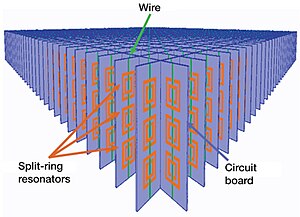A split-ring resonator (SRR) is an artificially produced structure common to metamaterials. Their purpose is to produce the desired magnetic susceptibility (magnetic response) in various types of metamaterials up to 200 terahertz. These media create the necessary strong magnetic coupling to an applied electromagnetic field, not otherwise available in conventional materials. For example, an effect such as negative permeability is produced with a periodic array of split ring resonators.[4]
A single cell SRR has a pair of enclosed loops with splits in them at opposite ends. The loops are made of nonmagneticmetal like copper and have a small gap between them. The loops can be concentric, or square, and gapped as needed. A magnetic flux penetrating the metal rings will induce rotating currents in the rings, which produce their own flux to enhance or oppose the incident field (depending on the SRRs resonant properties). This field pattern is dipolar. The small gaps between the rings produces large capacitance values which lower the resonating frequency. Hence the dimensions of the structure are small compared to the resonant wavelength. This results in low radiative losses, and very high quality factors.[4][5][6]
https://en.wikipedia.org/wiki/Split-ring_resonator











No comments:
Post a Comment